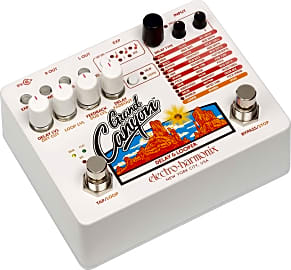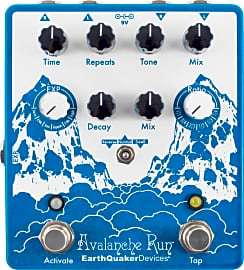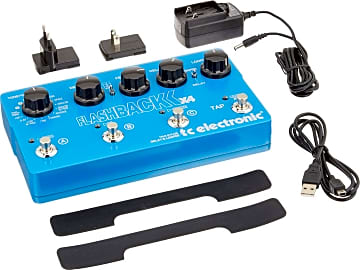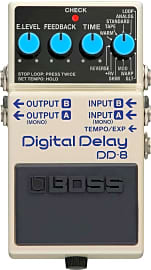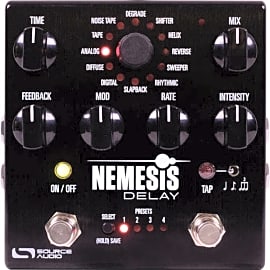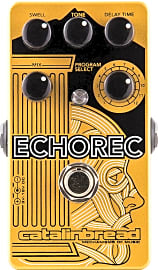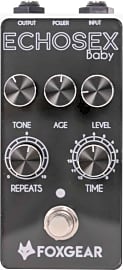The 10 Best Delay Pedals

This wiki has been updated 39 times since it was first published in October of 2015. Whether you're trying to create shimmering layers within your guitar lines, add a slap-back form of reverb to your vocals, or even do a small amount of looping, there's a delay pedal on our list that's sure to please. We've included the finest models designed for use on the floor or laid out on a pedal board, with an eye toward versatility, quality of overall tone, and durability. When users buy our independently chosen editorial choices, we may earn commissions to help fund the Wiki.
Editor's Notes
March 03, 2020:
One of the biggest bits of news in this sector was Boss finally coming out with a new model in their DD series. I've been playing guitar for 25 years, using the DD-3, 5, and 6, and I held out on the 7 thinking the 8 was right around the corner. It only took 12 years between models for Boss to come out with the Boss DD-8. Was the wait worth it? Yes and no. It's a fine option that offers a lot for its price point, but it probably would have done better had it come out four or five years ago, before the proliferation of no-name pedal companies executing simple circuit knock offs in factories overseas, and before the explosion of outstanding boutique offerings like the Earthquaker Devices Avalanche Run V2 or the Empress Effects Tape, both of which boast more versatility and similar signal-to-noise ratios, even if they do take up more board space.
We said goodbye to the Seymour Duncan Analog Vapor Trail for its lack of versatility, particularly in its signal modulation, and replaced it with the Foxgear Echo Sex Baby, a model that offers a particularly bombastic sound, and may end up replacing your reverb pedal if you use it right. We also saw upgrades to the Avalanche Run mentioned above and the Electro-Harmonix Grand Canyon Looper, which has been expanded significantly to include greater looping capabilities and a wider range of presets.
Delayed Reaction
In other words, there's less computing, compressing, and recreating of your original input sound, preserving more of its artistic integrity.
In the 25 years since I started playing guitar, I've never given up the need to tamper with the sound of the instrument. I have gotten a lot more disciplined about the number of pedals I use to achieve this tampering, but there are certain effects without which I cannot live. Among those, is at least one delay pedal. In my current setup, I have two, one of which is pretty high up on this list, and the other of which is technically a loop station.
Delay is a rather magical effect, moreso than many others in that it creates the sense of additional instruments, of a kind of specter repeating what you've played on into the night. Some would argue that its digital form is a little less magical than the analogue origins the effect boasts, but we'll quickly see how both kinds of delay have their advantages.
That magic comes from analogue delay's refusal to convert the incoming signal into a digital sample. In other words, there's less computing, compressing, and recreating of your original input sound, preserving more of its artistic integrity. Instead of creating, accessing, and manipulating a sample as the digital pedals do, analogue pedals send voltages along a pattern of capacitors in a system that greatly resembles a line of firemen passing along buckets of water. That's why this kind of delay pattern is often referred to as a bucket brigade.
On the output side, digital delay offers a lot more options for manipulation, as a digital sample can endure more deconstruction than an analogue signal can before decaying. Some artists prefer the more natural decay of an analogue device, while others like the increased amount of options afforded to you by a digital interface.
Any delay pedal you select will at least give you control over the length of time between delay repetitions, as well as the intensity of the delay effect, often through simple dial controls on the pedal's surface.
Control Freaks
Your style of music is completely your own. Even if you're the guitarist in a Led Zeppelin tribute band, you still have your own unique way of playing the guitar that's at least a little different than what Jimmy Page was up to. Each of the pedals on our list offers a different set of options for the control of your delay output, and you should take stock of your musical style before making a decision.
If you want a delay effect to continue more or less endlessly, you need a digital pedal.
I, for one, am an enormous fan of simplicity in delay, especially if I'm tracking and performing for a soundscape that has recognizable guitars in it. Sure, I like having a more complicated digital delay like the ones offered by BOSS when composing experimental music with a digital noise component, but my tastes in the sound of a guitar are distinctly analogue.
Look at your setup as it is. Let's start with your amp. Is it a tube amp or a solid-state creation? If you're pumping your sound through a tube amp, you're probably more in line with the analogue pedals on our list. Otherwise, a digital pedal might serve you just fine. Of course, if you're stuck on soild-state for money purposes, and you really want to get at that analogue sound, an analogue delay pedal would be a step in that direction.
But inside the debate between analogue and digital delay, there is the question of features and control. Analogue pedals provide a little less potential delay time, as manufacturers can only fit so many capacitors into a single pedal. Digital delay also offers pitch controls, reversal programs, and looping options that you might really enjoy. If you want a delay effect to continue more or less endlessly, you need a digital pedal.
If this is all getting a little heady for you, most of these pedal companies have samples for you to hear on their websites, which can give you an even better sense of their sound. Keep in mind, though, that they have tremendous control over that content, and the real-world application of the pedals might feel a little different.
Let's Go To The Tape
Delay as we know it started among the studio innovators and experimental composers of the 1950s and 60s, who used closed loops of thin magnetic tape to track sounds and instruments and play them back over and over. They would stretch the tape, speed it up and slow it down, or denigrate it with other magnets to achieve additional effects on the sound.
They would stretch the tape, speed it up and slow it down, or denigrate it with other magnets to achieve additional effects on the sound.
In the 1970s, solid state analogue delay pedals became available as the introduction of bucket brigade processing chips allowed designers and manufacturers the ability to recycle and time their signal processes.
Later that decade, companies like Sony and Philips utilized an advanced form of Pulse-code modulation to advance the field of digital recording. As music and telecom industries worked to standardize frequency-binary correspondences, effects designers sought to incorporate the tech into their pedals.
BOSS's DD-2, introduced in 1984, was the first such digital delay pedal to utilize this new digital signal processing, and the complexity and variety of the effects made available by the innovation only grows today.



